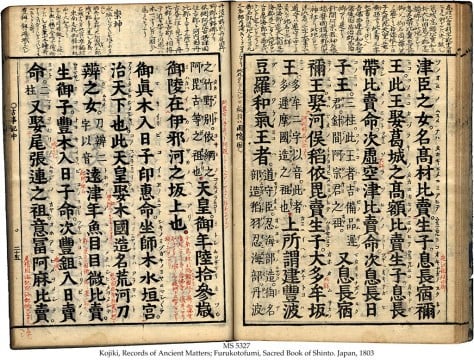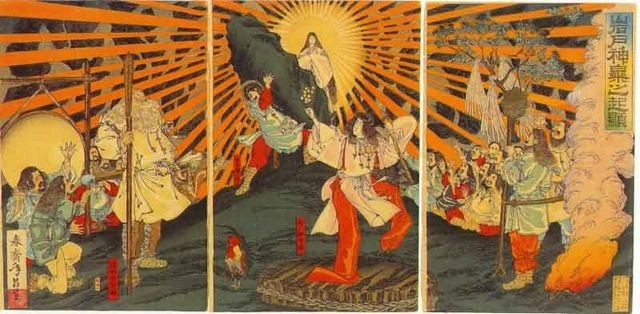The Kojiki (古事記) is considered the oldest book in the history of Japan and is also known as Furukotofumi. The writing of the relic is in the old Japanese language, such as the use of manyogana (Japanese writing with Chinese characters, used in the sixth century).
The writings of the Kojiki have tales dating back to the year 712 when Ō no Yasumaro presented them to Empress Gemmei. The stories also depict supernatural beings (very similar to those portrayed in anime). The tales are based on an earlier version with a similar name: Kujiki. The book is filled with songs and poems divided into three volumes representing the order of each one: Kamitsumaki ("upper roll"), Nakatsumaki ("middle roll"), and Shimotsumaki ("lower roll").
The first Kojiki contains a preface and the focus of the unit is on deities, as well as their creation and birth. The following book talks about the history of the Imperador Jimmu (first Japanese emperor) and ends with the life accounts of the Imperador Õjin (15th emperor of Japan). However, the stories are not considered true as they have a mix of reality and fiction. The emperors from the 2nd to the 9th of Japan are mentioned, but their conquests are not as complete as those of the others.
The last unit of the book highlights from the 16th to the 33rd Emperors and the difference in relation to Koijki's previous volumes is that it refers to relationships with the gods and the emperors from the 24th to the 33rd also have information that has been suppressed.

Table of Content
Kojiki's historical background
Kojiki is part of a historical context of political unification and social stratification in Japan that ended in 710. A little before Emperor Tenmu (672 – 686) ascended the throne to the fall of Emperor Kobus (672).
For the authorization of the development of the Kojiki, the genealogical record of the royal family was used as legends, traditions, manuscripts, songs and among others in which the court as a whole would benefit from the mystical narratives of the work that began to be written in 712. By That's why the first writings are concentrated on reigns and imperial succession, after which mystical stories emerged to explain the origin of everything.
The Kojiki was the subject of study during the Edo Period, by Metoori Norinaga (scholar) who wrote a research on the work and called it Kojiki - den divided into 44 volumes. It had an English translation called Basil Hall Chamberlain, but the most recent translation of the Kojiki is from 1968 translated by Donald Philippi.
The Ise and Urabe are considered the largest fragments of the Kojiki. The Ise is divided in the manuscript Shinpukuji-bon (真福寺本), from 1371-1372 (the oldest manuscript), and in the manuscripts Dōka-bon (道果本).
The Dōka-bon (1381) is one of the three subdivisions of Dōka. From the Dōka-bon, only the first half of volume one remains. Next is the Dōshō-bon (道祥本) from 1424, which also only contains the first volume and has flaws. And then there is the Shun'yu-bon (春瑜本) of a single volume.
The mythology depicted in Kojiki
Japanese mythology speaks of gods and how they emerged, their abilities, the creation of everything in the Universe, and the history of the emperors who rose to power. Some gods include the 太陽, the 月, the 星々, the 雨, the 風, and the 農業 and others. It also discusses the relationship between the good and evil of the deities and humans themselves.
The Kojiki says that the main gods are: Amenominakanushi (deity who presides over the universe), Takamimusubi (deity responsible for the creative force), Kamimusubi (creative deity), Umashiashikabihikoji (deity of shoots and reeds) and Amenotokotachi (deity of heavenly eternal abiding)..
In addition to these gods, considered the main ones, seven more generations emerged, in which Izanagi and Izanami emerged. The prefix at the beginning of their name IZA means to invite or lead. At the end of the name, it identifies the sex, being MI for female and GI for male. It is not possible to reach a consensus on what the relationship between them was, if they were brothers, married or something else.

For those who believe that Izanagi and Izanami are a couple, there is a belief that their union resulted in the emergence of the islands, Japanese archipelagos, after all, according to quotes, they were the ones who had the function of finalizing the creation of the universe. There were events that led to the birth of the Sun Goddess and her younger brother the Thunder God in which they had conflicts with each other.
If you pay close attention to the complete narrative of Kojiki, even with a lot of mysticism involved, it is possible to notice that it is a story with political interests of the rulers of the time in order for people to respect and accept rulers coming from the same lineage.
